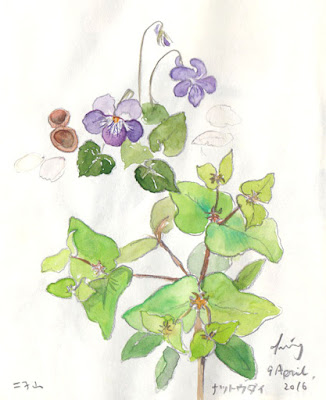Ichikaimachi in Tochigi prefecture is now called Sashiba no sato, the land of Grey-faced Buzzard. Small paddy fields stretch along every small valley between the hills and that is the typical favored habitat for the Grey-faced Buzzard.
サシバの里と言われる市貝町には、これぞ谷津田という景観があちこちに残っていて、どこもここもスケッチしたい風景だった。でも谷戸地形は、紙に表すのが難しい。

ウグイス、キビタキの声も聞こえるけれど、一番声を張り上げて歌っているのはガビチョウだった。やはり手入れをできる人が少ないらしく、山はけっこう薮だらけ。

でもさすが「サシバの里」というだけあって、入り組んだ谷戸のあちこちでサシバの姿を確認できた。ピックイーと言う声が聞けたのもうれしい。
 This area is designed only to protect the birds and habitat but not to welcome visitors. So there is no organised view point or trail to walk to see the buzzard so you just have to drive and watch them mainly from the car. I was rather worried that visitors may block the road and cause trouble with the locals.
This area is designed only to protect the birds and habitat but not to welcome visitors. So there is no organised view point or trail to walk to see the buzzard so you just have to drive and watch them mainly from the car. I was rather worried that visitors may block the road and cause trouble with the locals.

電柱や電線は真下の田んぼの中の餌を探せる格好の止まり場らしい。

出会ったおばあさんは、「サシバの里って言われて、それなりには個体数がいるみたいなんだけれど、まだわたしはサシバを見たことがないのよ。鳥はいろいろいるけれど、どれがサシバなのやら」と話していた。
ある意味では、人々が程よく無視するなかで、サシバがひっそり生きている、里山本来の姿なのかもしれない。観光資源としては、芝ざくらのほうがよほど人気らしい。

道の駅の駐車場をタガメが歩いていた!

























































